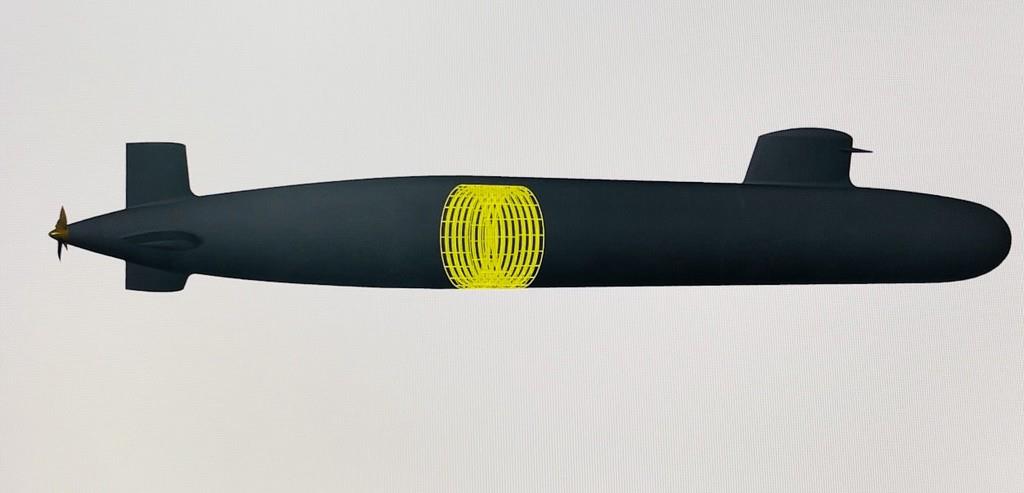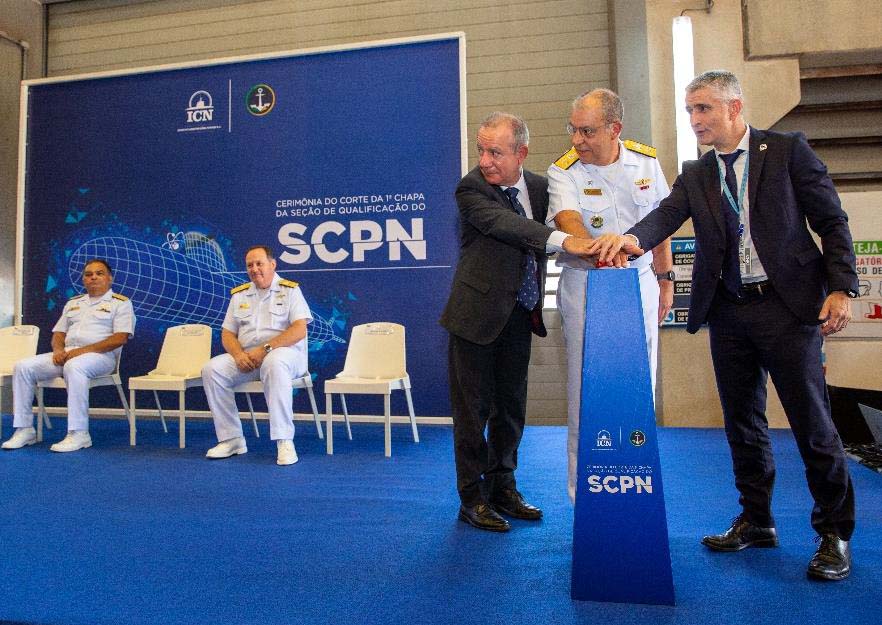On Wednesday (4), the Brazilian Navy (MB) held the First Plate Cutting Ceremony for the Qualification Section of the Conventionally Nuclear-Powered Submarine (SCPN), at the Itaguaí Naval Complex (CNI). The event, organized by the Navy’s General Directorate for Nuclear and Technological Development (DGDNTM), represents a significant milestone in the SCPN’s construction process.
Presided over by the Navy’s Director General for Nuclear and Technological Development, Admiral Petronio Augusto Siqueira de Aguiar, the ceremony was attended by Admirals Flávio Augusto Viana Rocha and Alexandre Rabello de Faria, and marked the beginning of the construction of the structure that makes up the so-called Qualification Section. The event was also attended by civil and military authorities, as well as representatives from the nuclear, academic and business sectors.
The Manager of the Modular Undertaking for the Procurement of Submarines, Rear Admiral Marcio Ximenes Virgínio da Silva, explained that although the Qualification Section will not be part of the submarine, it is essential to enable the construction process to be approved and, consequently, the shipyard to be certified to build the ship. “The first cutting of the plates to make the souls – which will form a series of caverns that will be joined to the plating – will make up the subsections and, finally, the Qualification Section. The homologation process involves other activities in addition to those directly linked to the core activities, such as moving between each workstation and analyzing the difficulties intrinsic to the processes, considering the weight of this section – approximately one hundred tons. The Qualification section will make it possible to gauge the capacity, unique in the southern hemisphere, to build a conventionally armed nuclear-powered submarine. Thus, this moment marks the beginning of the shipyard’s search for its qualification with the construction process to be approved, in order to allow the construction of the Submarine to begin in the future,” said Rear Admiral Ximenes.
The SCPN, the main objective of the Submarine Development Program, is the Navy’s most ambitious strategic program, as it enables the country to design and build conventional and nuclear-powered submarines, based mainly on the transfer of technology, the nationalization of equipment and systems, as well as the training of personnel, in addition to making a significant contribution to the creation of thousands of jobs. At the moment, the project involves around 1,500 military and civilian workers. The program, however, has the capacity to generate up to 24,000 direct jobs and 40,000 indirect jobs.
During the event, the president of Itaguaí Construções Navais (ICN), Renaud Poyet, highlighted the satisfaction of being part of this day together with all those responsible for achieving this great feat. “Brazil is taking a step that will raise our technology to the level of countries like France, the United States, China, England and Russia. And the Brazilian Navy, in command of this modern submarine, will have all the conditions to protect Brazil’s vast coastline,” said President Poyet.
The Navy’s Director General for Nuclear and Technological Development, Admiral Petronio Augusto Siqueira de Aguiar, accompanied by the President of the ICN and the General Coordinator of the Nuclear-Powered Submarine Development Program, Vice-Admiral (Naval Engineer Reserve) Sydney dos Santos Neves, activated the cutting device, beginning the new stage of construction.
First cut of the plates

Admiral Petronio then highlighted the extraordinary technological leap that the Program represents for Brazil, contributing substantially to the defense sector reaching a relevant strategic level for the legitimate interests of the Brazilian State. “We are sailing, duly informed, towards the conquest of a dream, the Conventionally Armed Submarine with Nuclear Propulsion, a legitimate aspiration for a country with a vocation to guarantee its sovereignty, defend its wealth and its people,” he said.
Welder Danusa Morais comments that she feels extremely proud to be part of PROSUB. “We were trained here at the CNI because the welding that will be used on the SCPN requires specific training and high quality.”


According to Dr. Inayá Corrêa Barbosa Lima, Professor of Nuclear Engineering at the Federal University of Rio de Janeiro (PEN/COPPE/UFRJ), the participation of universities and research institutes in PROSUB activities ensures the dissemination of knowledge of the nuclear sector in the country, enabling the retention of intellectual capital and avoiding the “brain drain” of the Brazilian nation.”
Source: Agência Marinha de Notícias
